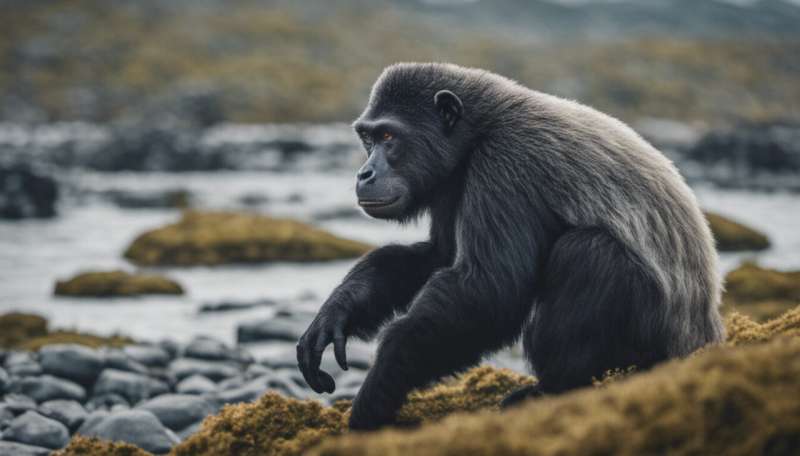Credit: AI-generated image (disclaimer)
Two new species of prehistoric primate were recently identified by scientists studying fossils from Canada's Ellesmere Island in the high Arctic. The primates are closely related and likely originated from a single colonization event, following which they split into two species: Ignacius dawsonae and Ignacius mckennai.
At 52 million years old, they represent the most recent known members of their genus.
The primates colonized the high latitudes during a period of historic global warming called the early Eocene climatic optimum (EECO). During this period, the high Arctic, now cold and inhospitable, had a climate similar to the cypress swamps of the southeastern U.S.. The primates shared the landscape with species that are today associated with warmer climates, including crocodilians and tapirs.
This warmer period had a major impact on biodiversity. But it also has important implications for our understanding of climate change today. Human impact on the climate is so dramatic that scientists are calling for the acknowledgement of a new geological period called the Anthropocene.
New Arctic primate fossils
The Ellesmere Ignacius species are known only from teeth and jaw fragments. But other species of Ignacius for which additional skeletal materials are available indicate a tree-living lifestyle similar to modern colugos, a gliding mammal native to southeast Asia. The new primates likely evolved from ancestral paromomyids (extinct gliding primates) from North America's southerly latitudes.
Based on tooth size, Ignacius dawsonae at 1.17 kg was twice as large as Ignacius clarkforkensis, the biggest mid-latitude member of the genus (0.47 kg). Ignacius mckennai at 1.98 kg may have been four times as large as its biggest southern cousin. The new Ignacius were roughly the size of a rabbit.
These results support Bergmann's Rule, a theory that links the climate to animal anatomy. It states that the colder the climate, the larger the animal. While the high Arctic was warmer during the EECO than it is today, its climate was still cooler than the ancestral range of Ignacius species.
As a shape gets bigger, its relative surface area to volume ratio gets smaller. This means the surface area over which heat is lost is relatively smaller for larger animals. To minimize heat loss, animals that live in colder climates tend to be bigger than similar species in warmer climates.
Penguins, for example, broadly follow Bergmann's rule. The large emperor penguin lives near the south pole, while smaller species such as the Humboldt penguin inhabit regions closer to the equator.
The Ellesmere Ignacius also exhibits large teeth and jaw muscles. The biomechanics indicate a high bite force with relatively low and serrated molars. This suggests a diet that included harder objects such as seeds and nuts that provided a food source during the long dark winters of such northerly latitudes.
The science of discovery
The fossils were excavated at multiple locations over several decades before being examined and photographed using micro-computed tomography. This is a modern technique that allows scientists to digitally map the anatomy of fossils embedded inside rocks.
The researchers then conducted phylogenetic analysis of the teeth and jaw fragments to determine identity and evolutionary relatedness to previously described species. They also compared tooth topography (a 3D landscape map of the tooth surface) with living and other fossil primates to determine the new species' likely diet.
Implications for future evolution
The EECO will have seen a turnover of animal species. As local climates warm, individual organisms have two options: move or die. At the species level, animals have a third option, to evolve over generations to adapt to changing environmental conditions.
The fact that mammals living in warmer climates colonized the changing Arctic habitat is likely because their own ancestral range was becoming too hot. This indicates the potential for migration, followed by evolutionary radiation, to fill opening ecological niches created by climate change.
But the colonization was selective. Several mammal species, including deer, antelope, horses and small herbivore groups lived in warmer regions further south but did not inhabit such northerly latitudes. A much greater variety of primitive primates also did not make Ellesmere their home during the EECO. Biodiversity in the High Arctic therefore remained lower than at more southerly latitudes.
The researchers suggest that temperature was not the main barrier to successful colonization. Instead it was probably the long winter darkness and the resultant effect on the availability of plant materials as food. Some mammal species were not capable of the transition.
History shows us that various mammals can move northwards and adapt, and that biodiversity can increase. But evolution needs two things: genetic diversity and time.
However, expanding human populations are having increasingly destructive effects on nature. Persecution and habitat loss have, for example, reduced population sizes and genetic diversity across species. Pollution also means that the climate is changing faster than ever before. It is thus harder for species to adapt.
Ironically, climate change may also explain why the Arctic Ignacius species went extinct. As Arctic temperatures again cooled, Ignacius likely found itself maladapted to the cold and unable to migrate south or compete with mid-latitude species that were better adapted to their environment.
Humans cheat the climate by using technology to evade environmental challenges. Air conditioning, central heating and clothes enable humans to survive in places that we would otherwise be unable to tolerate.
But we are vulnerable to climate change. If human-induced climate change continues, it is not just other animals that will experience the same fate as Ignacius. We will too.
Provided by The Conversation
This article is republished from The Conversation under a Creative Commons license. Read the original article.![]()
























